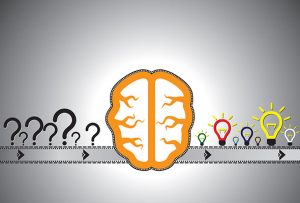Charles Darwin once said, “It is not the strongest of the species that survives, nor the most intelligent that survives. It is the one most adaptable to change.”
If there was ever a time to be adaptable to change it is NOW. Driven by digital transformation, no one can rest on his or her laurels.
A major component to adaptability is a commitment to lifelong learning. Incorporating it into an already busy schedule is a primary challenge for many small business owners.
Learning On-The-Job Falls Short
Did you know that some of the most successful business owners do not have a formal education? They are who author, Michael Gerber, talked about in The E-myth: masters of their crafts.
We are business coaches, accountants, therapists, designers, and attorneys who have parlayed out skills and expertise into a small business. Minus an MBA, our learning for budgeting, marketing, and operations (for starters) has been on-the-job.
On-the-job training served us well for a period of time. Nonetheless, with the ever-increasing pace of change, new times call for new methods. We can no longer wait for “learning opportunities” to pop up during our day-to-day operations.
What is needed to keep pace with change is a system for learning.
Learning at the Speed of Information
One of the biggest barriers to learning is access to the right information, especially when you consider the amount of information created daily. In a recent documentary entitled, “A Closer Look at the Human Face of Big Data,” PBS quantified the avalanche of information we face daily.
- During the first day of a baby’s life, the amount of data generated by humanity is equivalent to 70 times the information contained in the Library of Congress.
- Every two days the human race is now generating as much data as was generated from the dawn of humanity through 2003.
- We are exposed to as much information in a day as our 15th century ancestors were exposed to in a lifetime.
Given this report, it’s easy to see why many small business owners struggle with keeping up with all that is changing. Staying relevant, in order to keep your business growing, has its many benefits — and is no longer optional.
Those committed to life-long learning note it’s many advantages, including
- feeling more capable and well rounded
- opening up new perspectives
- making new friends by expanding their network
- feeling more connected
How to Develop a Lifelong Learning System
Randall Stephenson, the AT&T CEO and Chair, recently told the New York Times, “There is a need to retool yourself, and you should not expect to stop…People who do not spend five to 10 hours a week in online learning will obsolete themselves with the technology.”
Long before Mr. Stephenson touted the importance of 5–10 hours of weekly learning, Ben Franklin, one of the most prolific inventors of our time, demonstrated the rewards of such a practice.
History tells us that Ben Franklin arose an hour earlier each day to read and write. He blocked out this time for reflection, improvement, growth, and learning. He tracked his personal and professional goals and turned his ideas into experiments and inventions. His learning was deliberate, intentional, and systematic.
Here are four steps to guide the development of an intentional life-long learning system akin to Ben Franklin’s:
-
- Know your learning style.
Each of us has a different way in which we learn best. Some people prefer to interact with information by reading and writing. Auditory learners learn best by hearing information. Visual learners retain information best when it’s presented in a visual manner through graphs or pictures. Finally, experiential learners learn best through hands-on experience.Understanding your ideal learning style helps you choose the medium, style, or platform that works best for you.
- Understand the time available to dedicate to learning.
Ben Franklin dedicated himself to five hours of learning each week. Others, like Bill Gates, have successfully followed his lead.It can be daunting to set aside five hours per week for personal and professional learning – until you realize that the average person spends 50 minutes each day on Facebook and five hours every day watching TV.
- Understand your drive to learn.
Be clear on your intended outcome. (Having a goal is how adults learn best.) Avoid cerebral snacking by answering the question “why” beyond “read this book” to make your time count.Someone once asked me, “Do you have one year experience repeated 10X or do you have 10 years of experience?”
Learning with purpose ensures your experiences — and success — grow each year.
- Collaborate and cooperate to expedite learning.
Given the massive amount of information being produced every day, it is not possible to have all of the best information on a particular subject readily available to you.One of the quickest learning practices is to get involved in a mastermind group. Surrounded by like-minded business owners, you can absorb the experiences of others and accelerate your learning objective.
Open Your Mind and Say Ahhhhh…
If committing time to lifelong learning feels like it’s “one more thing to do,” you can also follow Josh Waitzkin’s lead. Instead of squeezing his days to maximize productivity, he creates slack in each day. His daily “empty space” is done purposefully. The extra slack in his schedule allows him to learn, create, and perform at a higher level.
Whether you’re more inclined to use the Franklin or Waitzkin’s method, doesn’t matter. The important thing is to be intentional in developing your system to become a life-long learner.
 When you’re well-versed on the 200 + coaching competencies, coaching is second-nature. When such an occurrence arises, I do what any self-respecting business coach does. I engage in a round of self-coaching. After all, how bad can it be? (Sounds a bit frightening, doesn’t it? Like a surgeon performing an appendectomy on themselves.)
When you’re well-versed on the 200 + coaching competencies, coaching is second-nature. When such an occurrence arises, I do what any self-respecting business coach does. I engage in a round of self-coaching. After all, how bad can it be? (Sounds a bit frightening, doesn’t it? Like a surgeon performing an appendectomy on themselves.)



 Consumers Willing to Pay More for Good Experience
Consumers Willing to Pay More for Good Experience Describe Your Customer Experience
Describe Your Customer Experience